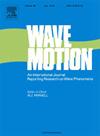浅水各向异性板弯曲重力波的变换隐身
IF 2.5
3区 物理与天体物理
Q2 ACOUSTICS
引用次数: 0
摘要
隐形原理已经发展并应用于不同类型的波浪。为了减小对物体的波浪力,我们考虑了在浅水弯曲重力波环境下的应用。利用空间变换方法对波的传播方程进行求解,得到了在物体附近用于制造斗篷的板的参数。Kirchhoff-Love平板的控制方程通常不是形状不变的,这在传统的(因此近似的)使用空间变换方法时会产生误差项。首先利用变分原理推导了浅-水-全各向异性板块系统的运动方程,将变换方法推广到各向异性板块,证明了在每一次坐标变化的情况下,存在一类各向异性板块的运动方程是形状不变的。此外,我们还考虑了当一个刚性的底部垂直圆柱体被一个带有遮蔽区域的浮板包围时,波浪力和散射被减小的例子,该浮板的材料参数是用所提出的方法计算的,我们通过模拟说明了一个近似的情况。本文章由计算机程序翻译,如有差异,请以英文原文为准。
Transformation-based cloaking for flexural–gravity waves in an anisotropic plate floating on shallow water
The principle of cloaking has been developed and applied to different types of waves. We consider the application in the context of flexural–gravity waves on shallow water in order to reduce the wave force on an object. The parameters of the plate used to create a cloak in the vicinity of the object are found applying a space transformation method to the wave-propagation equation. The governing equation of a Kirchhoff–Love plate is generally not shape-invariant, which traditionally induces error terms in the (thus approximate) use of the space transformation method. First deriving the equations of motion for the shallow-water–fully anisotropic plate system by a variational principle, we extend the transformation method to anisotropic plates and show that for every change of coordinates there exists a class of anisotropic plates such that the equation of motion is shape-invariant. Furthermore, we consider examples in which the wave force on and the scattering by a rigid bottom-mounted vertical cylinder are reduced when surrounded by a floating plate with a cloaking region having material parameters computed by the presented method and we illustrate an approximate case by simulations.
求助全文
通过发布文献求助,成功后即可免费获取论文全文。
去求助
来源期刊

Wave Motion
物理-力学
CiteScore
4.10
自引率
8.30%
发文量
118
审稿时长
3 months
期刊介绍:
Wave Motion is devoted to the cross fertilization of ideas, and to stimulating interaction between workers in various research areas in which wave propagation phenomena play a dominant role. The description and analysis of wave propagation phenomena provides a unifying thread connecting diverse areas of engineering and the physical sciences such as acoustics, optics, geophysics, seismology, electromagnetic theory, solid and fluid mechanics.
The journal publishes papers on analytical, numerical and experimental methods. Papers that address fundamentally new topics in wave phenomena or develop wave propagation methods for solving direct and inverse problems are of interest to the journal.
 求助内容:
求助内容: 应助结果提醒方式:
应助结果提醒方式:


